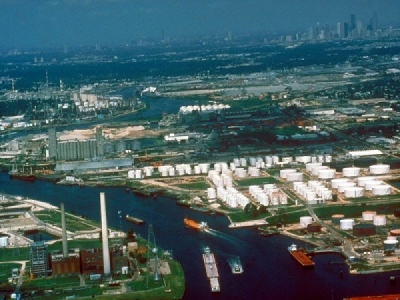
Posted on April 3, 2018
The loading of VLCCs is not on the radar at Port Houston under its channel development program primarily for financial reasons, even though crude exports from the Greater Houston area are forecast to grow, port officials told S&P Global Platts this week.
* Dredging costs seen over $1 bil
* 2018 crude exports could rise 45%
* Aframaxs will be main workhorse
Deepening the 52-mile Houston Ship Channel to accommodate VLCCs would keep pace with other projects around the country, said Mark Vincent, director of the Port Houston Channel Development.
But the port has determined that the cost will likely be over $1 billion, he said.
Besides dredging the main channel to 52 feet to load VLCCs — compared with depths currently between 36 feet to 45 feet — there would also be a need to extend the ship channel 20 miles further into the Gulf, he said.
“The benefits of dredging to bring in larger vessels might be sky-high,” Vincent said. “But the benefit/cost ratio might not be competitive with smaller federal projects.”
Corpus Christi, which is positioning itself to be a leading port for the export of crude to global markets, has estimated the capital cost of dredging its main channel to 52 feet at $327 million, besides spending another roughly $800 million to build a new bridge to allow vertical entrance of up to 205 feet, from the current 138 feet.
Dredging work on the 36-mile channel at Corpus Christi is due to start in the summer.
CHANNEL DEVELOPMENT
A final study on the Port Houston Channel Development project, kicked off in November 2015, is due to be completed in 18 months and it is “looking more likely” that the recommendation will be to increase the width of the main channel to accommodate more crude oil and general cargo vessels both ways, Bill Diehl, president of the Greater Houston Port Bureau, said in a separate interview.
The Greater Houston Bureau represents the ports of Houston, Freeport, Galveston and Texas City.
The current width is 530 feet for main vessels, while another 235 feet is available on two sides on the channel to ship crude on barges, Diehl added.
The estimated $10 million study, being carried out by Port Houston and the US Army Corps of Engineers, is targeted to increase the port “efficiency” and will include “deepening and widening” of the channel from the Boggy Bayou to the Turning Basin and improvements to the side channel, according to a draft Environmental Impact Statement prepared by the USACE.
The study will propose deepening the ship channel in several key locations, Vincent said, including the dredging of up to 4 feet to 5 feet near the Beltway Bridge.
But such efforts will benefit bulk carriers and not necessarily crude vessels, Vincent noted.
RISING CRUDE EXPORTS
With producers in the Permian Basin seeking growing opportunities to export crude from the USGC to global markets, the benefits will come to both Port Houston, its sister facilities and Corpus Christi, Diehl said.
Permian output is projected to reach 5.037 million b/d by 2020, compared with 3.59 million b/d this year, according to S&P Global Platts Analytics.
“The windfall will benefit all Texas ports. Corpus Christi will take the lead with VLCCs, while in the Greater Houston area the main workhorses will be Aframax and Suezmax ,” Diehl said, adding that while Aframaxes are fully loaded to their 750,000-barrel capacity, Suezmaxes are loading up to 85% of their total 1-million barrel capacity.
“Corpus [Christi] makes sense if you want to invest in new storage and docks, as the Houston Ship Channel already has those facilities,” Diehl said.
Total crude oil exports in from the four ports in the Greater Houston area stood 418,000 b/d in December 2017, up from at 114,000 b/d in December 2016, according to the US Census Bureau.
“The word out there is crude exports will rise another 45% in 2018,” Diehl said.
Midstream major Enterprise Product Partners, which in January exported 275,000 b/d of crude from the Houston Ship Channel, is due to ramp up throughput on its Midland to Sealy pipeline to full capacity of 450,000 b/d by the second quarter of 2018, the company said on its Investor Day webcast in early March.
The 416-mile pipeline that ships barrels from the Permian Basin to Sealy near Houston and onto the ship channel was started up late 2017.
It is one of the two pipelines that the company will use to transport crude from the Permian, besides repurposing an NGL line that can move 200,000 b/d.
Source: Hellenic Shipping News





